Iraq crisis: Isis offensive years in the planning has turned into a bloody, merciless rampage
Islamist attacks bear remarkable similarities to plans of its predecessor in Iraq eight years ago

The capture of city after city by the Sunni jihadists in Iraq has been due, it has been held in some quarters, to the collapse of the government’s forces rather than the strategy of an insurgent group known more for its proclivity for violence than planning.
However, the actions of the Islamic State of Iraq and the Levant (Isis) have been anything but ad hoc in either Iraq or Syria through which its fighters have cut a bloody swathe; its success against the forces of Bashar al-Assad and the government of Nouri al-Maliki has, indeed, followed detailed work on tactics.
The current offensive – which has led to Isis capturing territory from Mosul to the outskirts of Samarra and towns in Diyala while, at the same time, consolidating past gains in Anbar including Fallujah – bears remarkable similarities to operational plans drawn up by the group’s predecessor, the Islamic State in Iraq (ISI) eight years ago.
The first evidence of the “Baghdad Belts” mission was discovered in a roughly drawn map found on the body of Abu Musab al-Zarqawi, the man who turned ISI into a ferocious enemy of the West, after he was killed in a US air strike in June 2006. Further evidence emerged of how the aim was to seize key areas around the capital and funnel through gunmen, weapons, car bombs and surface-to-air missiles into the city.
The death of Zarqawi, and then the “surge” of US forces under General David Petraeus stopped the implementation of that plan. However, one of the men who played a part in drawing it up at the time, Abu Suleiman al-Nasser, became the “war minister” in Isis.
The Iraqi government claimed to have killed Nasser – whose real name is Neaman Salman Mansour al-Zaidi – in February 2011. But, it is believed he survived the attack and remains a close adviser to Abu Omar al-Baghdadi, the head of Isis.
The Zarqawi group had also envisaged the capture of Iraqi government military bases to seize weapons for use against the enemy. In Syria, one of the major operations carried out by Isis was the seizure of Menagh airbase, near Aleppo, in the summer of 2013. The attack was carried out in conjunction with the Free Syrian Army before the two groups began fighting each other in an attritional civil war.
In the east of the country, Isis seized oilfields, expelling other rebel groups in the area; it even, after a while, began selling some of the oil back to the regime.
In Iraq, Isis gained significant stockpiles of arms, as well as millions of dollars from the banks, after overrunning Mosul last week. Even if its forces are pushed out of the city in the future, the loot will be massively useful in Iraq as well as in Syria. It is also in a position to control oilfields, although it is improbable that it will be able to exploit them as it has done in Syria.
The groundwork for the advance now was laid at the beginning of the year, with the capture of Fallujah and other parts of Anbar. It was viewed at the time as the group taking advantage of Sunni unrest in Iraq while Syria remained the focus of interest. Instead, the province became the base for further strikes in Iraq, with bombings in northern Babil and southern Baghdad.
By April, Isis had taken control of Karma and Abu Ghraib to the west of Baghdad, and then the towns of Mahmoudiyah, Iskandariyah and Yusufiyah to the south of the capital.
Now Isis has taken Tikrit, Bayji, Jalula and Saadiyah, and is poised to move into Khalis and Baquba, the place where Zarqawi was killed carrying the “Baghdad Belts” map. The group’s spokesman, Abu Mohammed al-Adnani, may declare the aim is to sweep on to the Shia holy cities of Najaf and Karbala, but attempts to capture the capital remain a more realistic prospect.
It could be, of course, the case that just as the “Belts” plan failed to come to fruition with the US surge and the mobilisation of tribal elders in the “Sunni Awakening”, so the current offensive may wither if Barack Obama orders air strikes and the Iraqi government forces, Shia volunteers and the Kurdish peshmerga form a cohesive coalition.
But that, one assumes, won’t mean the end to jihad and the plans to establish the Islamic State in Iraq and Syria.
Subscribe to Independent Premium to bookmark this article
Want to bookmark your favourite articles and stories to read or reference later? Start your Independent Premium subscription today.

Join our commenting forum
Join thought-provoking conversations, follow other Independent readers and see their replies